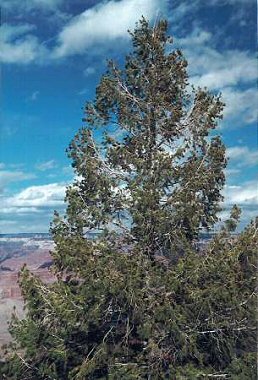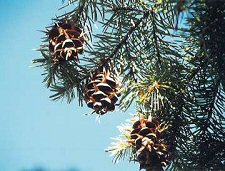DOUGLAS-FIR
Pine Family
Pseudotsuga menziesii

True firs belong to the genus Abies, but Douglas-fir has its own
genus Pseudotsuga. Doug fir is a large straight-trunked tree, here
about the size of Grand Canyon's ponderosa pines. The rough gray trunk is about
2 or 3 feet in diameter. Young trees and upper trunk can have smooth white bark
like the white fir, a much less common tree in the area. With few exceptions,
both Douglas-fir and white fir grow only below
the South Rim, on shaded north-facing slopes and cliffs of the Kaibab and
Toroweap Formations. Here a cooler micro-climate mimics the trees' preferred
environment around 8,000 feet and above.
Douglas-fir vies with ponderosa pine in its importance as a lumber tree in
the United States.

Unlike the cones of true firs, those of Douglas-fir hang downward and have distinctive 3-pointed, papery bracts extending out from the scales. Some call these "mouse-tails" but they are more like the two hind feet and the tail. Immature cones are a beautiful deep purple color. Cones persist throughout the winter. The Douglas-fir needles are short like those of the Pinyon Pine.